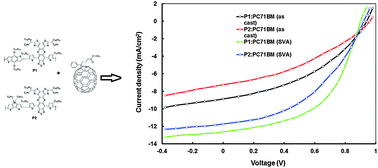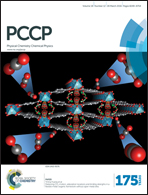New low bandgap near-IR conjugated D–A copolymers for BHJ polymer solar cell applications†
Abstract
We synthesized two novel ultra low bandgap donor–acceptor (D–A) copolymers (Eg ≤ 1.2 eV), containing the thiadiazoloquinoxaline unit as the main electron accepting unit (A) and benzodithiophene (BDT) and dithienosilole (DTS) as different donor units (D), denoted as P1 and P2, respectively, using the cross-coupling Stille reaction. The copolymers possess light absorption ranging from UV (350 nm) to near-IR (1300 nm) with optical bandgaps of 1.16 eV and 1.08 eV, respectively. Quantum-chemical calculations and experimental data were compared for proposing a more detailed concept for the optical and electronic properties of these copolymers which can be used as donors for polymer solar cells (PSCs). The PSCs based on optimized P1:PC71BM and P2:PC71BM showed overall power conversion efficiencies (PCEs) of 4.32% and 3.48%, respectively. Although P2 possesses a broad absorption coverage of up to 1300 nm, the lower PCE may be attributed to the low Jsc, due to the poor driving force for exciton dissociation, since the LUMO offset with PC71BM is less than 0.3 eV. The PCE has been significantly increased to 7.27% and 6.68% for solvent vapor annealing (SVA) treated P1:PC71BM and P2:PC71BM active layers, respectively. This improvement arises from the appropriate nanoscale morphology and an increase in hole mobility, induced by the SVA treatment of the active layers.


 Please wait while we load your content...
Please wait while we load your content...